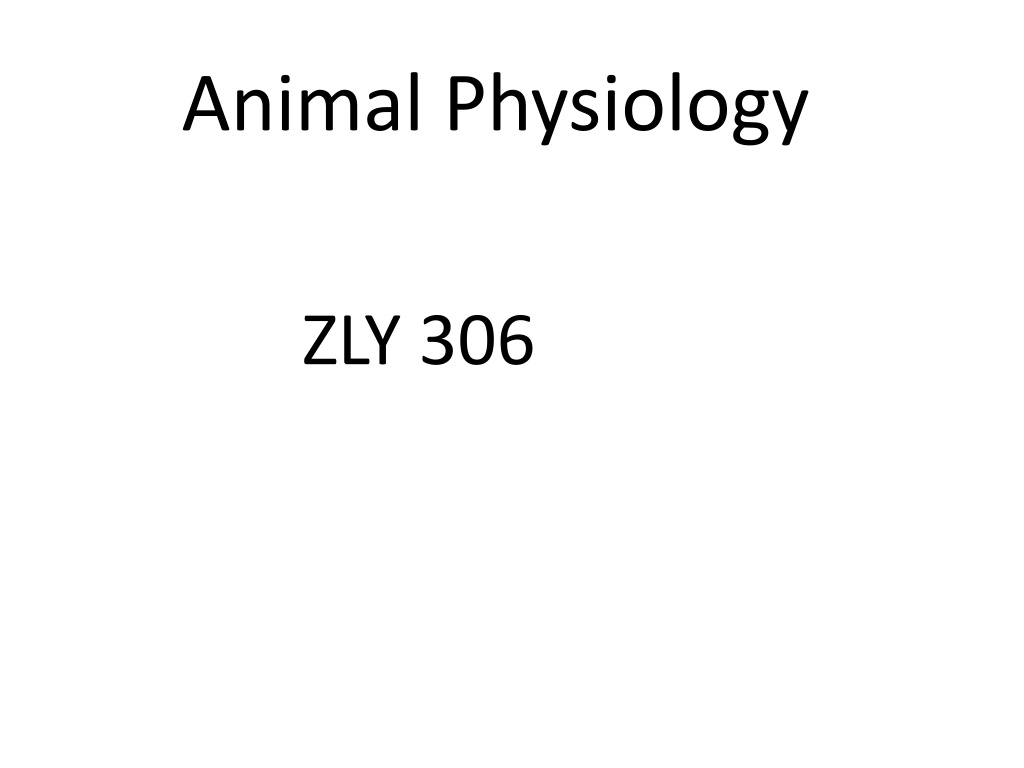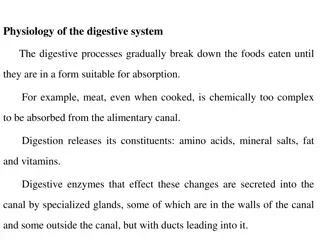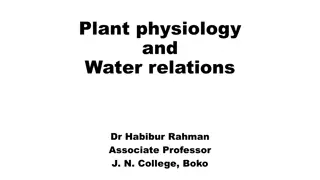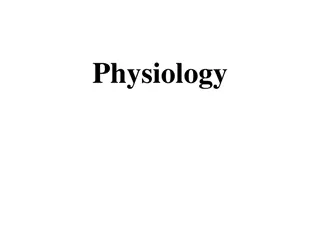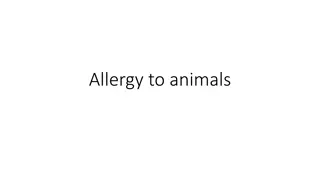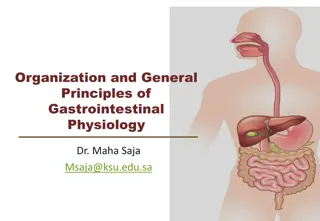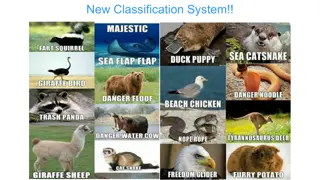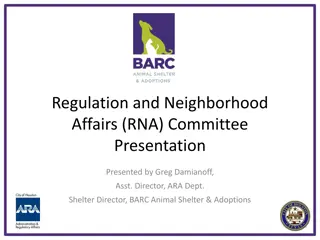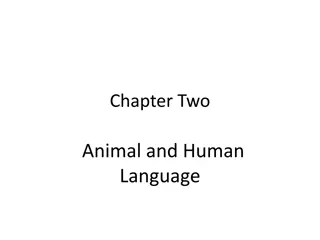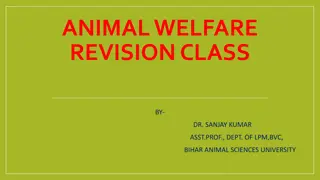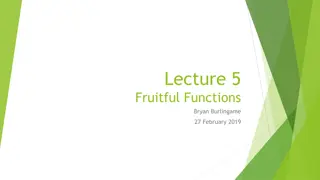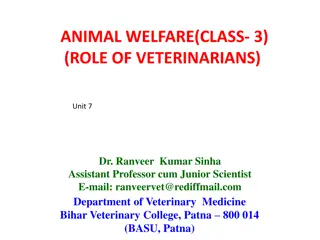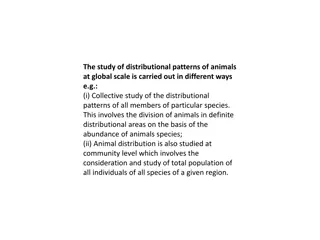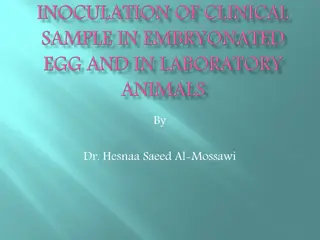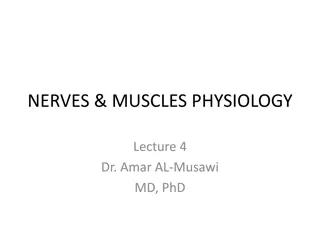Exploring Animal Physiology: Functions and Processes
Animal physiology is the study of how animals function and their bodily processes. It delves into feeding mechanisms, digestion in various animals, and the energy requirements that drive their activities. Explore the nutritional requirements of animals, the types of food they need, and the mechanisms by which they process food for energy and growth.
Download Presentation

Please find below an Image/Link to download the presentation.
The content on the website is provided AS IS for your information and personal use only. It may not be sold, licensed, or shared on other websites without obtaining consent from the author. Download presentation by click this link. If you encounter any issues during the download, it is possible that the publisher has removed the file from their server.
E N D
Presentation Transcript
Animal Physiology ZLY 306
Animal physiology is the study of animal functions and bodily processes.
Course Outline Feeding Mechanisms - Filter feeders, Deposit feeders, Fluid feeders, Carnivores and Herbivores. - Digestion in Mollusc, herbivores, insects and mammals - Cellulose digestion in herbivores and wood eating animals
Text books Basic Animal Physiology by William Ose Odiete Integrated Principles of Zoology by Hickman Roberts, Keen Larson,L Anson Eisenhour
Introduction All organisms require energy in order to maintain their complex structure, development and daily activities. The sun is the ultimate source of energy for all life on the earth s surface. However you will agree that not all organisms are able to utilise the energy from the sun directly
Hence we require a medium which will allow us to utilise the energy from the sun. How? AUTOTROPHIC ORGANISM require only inorganic compounds absorbed from their surroundings to provide raw materials for synthesis and growth.
Table of Contents Nutritional Requirements Food Types Feeding Mechanisms Overview of Food Processing (Click on topics to access slides)
Nutritional Requirements Animals are heterotrophs that require food for fuel, carbon skeletons, and essential nutrients. By definition a heterotroph is an organism that obtains organic food molecules by eating other organisms or their by-products.
A nutritionally adequate diet satisfies three needs: Fuel , chemical energy; for the cellular work of the body. Organic Raw Materials in the form of carbon skeletons used in biosynthesis Essential Nutrients which are substances that the animal cannot make for itself from any raw material and must be obtained from food in a prefabricated form 1. 2. 3.
Food Types Animals fit into one of three dietary categories: 1. Herbivores, animals that eat mainly autotrophs (plant and algae) 2. Carnivores, animals that eat other animals 3. Omnivores, animals that regularly consume animals as well as plant or algal matter However, most animals are opportunistic feeders; eating foods that are outside their main dietary category when these foods are available. (Click on highlighted words for links to web resources)
Feeding Mechanisms Diverse feeding adaptations have evolved among animals. Four main groups of mechanisms by which animals ingest food: Suspension-feeders: (filter feeders) many aquatic animals that sift small food particles from the water. Substrate-feeders (deposit-feeders): animals that live in or on their feed source, eating their way through the food Fluid-feeders: animals that survive by sucking nutrient-rich fluids from a living host Bulk-feeders: animals that eat relatively large pieces of food
Overview of Food Processing The four stages of food processing: 1. Ingestion: the act of eating 2. Digestion: enzymatic breakdown of the macromolecules of food into their monomers 3. Absorption: body cells take up nutrients such as amino acids and simple sugars from the digestive system 4. Elimination: occurs as undigested material passes out of the digestive system as feces
WHO EATS WHAT? Dogs eat bones Goats eat leaves Cat eat rats Rat eats fish Fowls eat grains Hawks eat chicken
Animal foods are often so bulky to be absorbed directly. Hence different food habits have been developed by different animals in order to transform it into a form at which it can be utilised All food categories are based on dietary habits
Categories of feeding HERBIVORES Feed mainly on plant life CARNIVOROUS - feed mainly on herbivores and other carnivores OMNIVOROUS eats both plants and animals SAPROPHAGOUS animals feed on decaying organic matter
Suspension/Filter feeder A filter feeder is any animal that obtains food by filtering water for nutritious particles. A filter feeder is also known as a suspension feeder, Examples of a filter feeder include, flamingos, clams, sponges and blue whales. A filter feeder uses some mechanism, like a filter basket, or baleen (as in baleen and blue whales) to gather aquatic prey usually plankton These are siphoned it to their mouths for consumption and digestion.
Sharks that eat plankton have specialized feeding mechanisms. The basking shark eats plankton by swimming at the surface with its mouth open. The water rushes through the mouth and out the gills. Gill rakers at the entrance to the gill catch and filter out all of the plankton (small organisms that float in the water). Gill rakers, are numerous in the basking shark, but are shed in the winter when the food supply of plankton is scarce Gill raker
http://www.dfw.state.or.us/mrp/fishid/images/Gill_Arch.jpg http://www.cabrillo.edu/~jcarothers/lab/notes/fishapods/VISUALS/pagepics/MainFrame_clip_image002_0001.png
Filter feeding Many bivalve molluscs, for example the mussel Mytilus edulis, feed on particles suspended in the surrounding water. They do this by filter feeding. The mussel lives in the intertidal zone, attached to a solid surface by threads secreted by the muscular foot, so it is not able to move around like some related molluscs.
When it is covered by seawater, the two shells open slightly, allowing water to enter the body of the mollusc, which is protected by the shell when the tide is out. From this extend a pair of short tubes, also called siphons.
A current of water is drawn in through one opening, then across the gills and out through another opening. This movement is powered by the combined effect of many cilia: hair-like projections from cells lining the spaces inside the mussel's shell.
The gills hang down like net curtains, trapping small particles as well as extracting dissolved oxygen from the water. Cilia on the filaments send a current of mucus down each strand and then onward towards the mouth. Any particles of a suitable size which are trapped are then digested. Incidentally, this is not unlike the means by which foreign particles including bacteria are trapped in mucus in the human respiratory system, and then taken into the stomach and digested
Deposit/Substrate feeders Deposit feeders obtain food particles by sifting through soil, vaguely analogous to the way that filter feeders get food by filtering water. Prominent examples are earthworms, other annelids such as polychaete worms, and fiddler crabs Deposit feeding is a feeding strategy that only works in fertile areas with a lot of pre-existing life. The top layer of soil is targeted, typically within six inches of the surface, as this is the soil most likely to contain food particles that haven't been completely broken down yet. Biologists call these food particles detritus. After detritus has been broken down to a chemically neutral state, it becomes known as humus. .
Fluid feeders Animals that obtain their nutrients by consuming fluids from another organisms are called fluid feeders. Animals which practice fluid feeding include hummingbirds spiders, aphids, ticks, mosquitos, leeches. bees and butterflies. Fluid feeding is defined as getting your nutrients by consuming the fluids of another organism
Fluid Feeders Fluid feeding is obviously a successful mode, and has probably been around since insects first crawled onto land about 428 million years ago, during the Devonian period
The most despised fluid feeders are those that feed on human blood, spreading infections and some of the worst diseases . Mosquitos spread malaria, which afflicts half a billion people every year and kills between one and three million
Fluid feeders need some way to pierce the protective wall (skin or plant walls) getting in the way of the fluid, then some proboscis-like appendage for sucking out all the fluids. Aphids are specialized in doing this with plants, which is why they can be found in such numbers on certain plants, especially those that produce an abundance of sweet fluid.
Bulk feeders Bulk feeding is one of the feeding strategies used by animals to obtain food. Bulk feeding is exhibited by animals that eat pieces of other organisms or swallow them whole. Bulk feeding is one of the most common feeding strategies among animals, especially among macroscopic animals, with which we are most familiar. Many herbivores, carnivores, and omnivores employ bulk feeding
Bulk feeders http://t1.gstatic.com/images?q=tbn:ANd9GcScduPldHM_l7sa8rEKWHMSOVNY_QYey-clrsyvVcs_OBZCmgG-JA
Some bulk feeders, such as cows, are specialized for consuming plants, and have large barrel-like stomachs to break down difficult-to-digest grass. Others, such as felines and canids are specialized carnivores, evolved to hunt down living organisms, kill them, and consume the fresh kill.
I. Mechanisms for dealing with small particles. A. Pseudopodial (e.g., many protozoans). Pseudopods consist of fingerlike projections of the cell membrane and its contents (cytoplasm) that surround and engulf food. B. Ciliary (e.g., sponges, bivalve mollusks). Cilia are minute hairlike projections of cell membranes that, by concerted beating in wave rhythm, set up water currents or physically move food particles. C. Tentacular (e.g., certain sea cucumbers). Tentacles are slender, flexible organs on the head. They may function in sensory perception and in actually securing food.
D. Mucoid (e.g., many snails, such as Vermetus). In this case, the food particles become attached to a sticky mucous sheet secreted by special cells. E. Muscular (e.g., certain coelenterates). In the jellyfish Rhizostoma, pulsations of the bell-shaped body draw water and food in through perforations in the arms, then expel the water after the food is removed. F. Setous (e.g., many small crustaceans, such as copepods). Setae are bristle like projections of the cuticle and are found on the appendages of many invertebrates.
II. Mechanisms for dealing with large particles or masses. A. For swallowing inactive food, such as bottom deposits (e.g., many polychaete worms, some fishes). B. For scraping and boring (e.g., some gastropod and bivalve mollusks). C. For seizing prey. 1. For seizing and swallowing only (e.g., Hydra, many polychaete worms, many lower vertebrates). 2. For seizing and masticating (e.g., Crustacea, mammals).
3. For seizing followed by external digestion (e.g., some starfishes, spiders). (In such cases, the secretory and absorptive surfaces of the digestive system may be applied to the food by everting [i.e., turning inside out] the stomach, a method employed by starfish. 4. Alternatively, digestive enzymes may be injected into the prey, liquefying the tissues, which may then be ingested by the predator. This mechanism is found in spiders.)
III. Mechanisms for taking in fluid or soft tissues. A. For piercing and sucking (e.g., leeches, mosquitoes). B. For sucking only (e.g., many flies, butterflies). C. For absorption through surface of body (e.g., various invertebrates feeding on decaying organic matter, internal parasites such as tapeworms, which lack a digestive tract). A different classification, often used, rests on the nature of the behaviour for procuring food: A. Filter feeders strain food from the surrounding medium more or less indiscriminately. B. Selective feeders analyze the environment with their sense organs before aiming feeding responses at chosen items.
Some feeding patterns, however, cannot be easily fitted into either of these classes alone; spiders, for example, sieve prey from the air with webs but perform directed responses to the insects trapped. Selective feeding requires good sensory and nervous equipment and, in most cases, considerable mobility. It is therefore found mainly among higher animals.
The primitive sea anemones are selective feeders in that, capable of paralyzing relatively large prey with their stinging cells, they do not discharge them until informed by chemical and tactile senses that prey is present. At the other extreme, whalebone whales are filter feeders, even though they are highly evolved mammals. Swimming at the surface with mouth open, they filter off large plankton (krill) using several hundred horny plates with hairlike fringes hanging down from the roof of the mouth; availability of a rich food source has caused the evolution of their feeding patterns to diverge widely from that of most other mammals.
Feeding patterns adopted by species are the result of evolutionary interplay between (1) structural properties inherent in their phylogenetic line (2) the ecological situations to which they have been exposed. These interactions are too complex to make generalizations profitable. The best approach is to study each species as a separate case in the light of its entire biology
Herbivores There are 3 groups of animals that have sucessfully adopted herbivores feeding habit. These are Gastropod mollusca Insects Herbivorous mammals
Hebivores have chewing , biting rasping or grazing mouthparts for dealing with plant materials
As different as the methods of nutrition may be among snails (there are herbivores, omnivores and carnivores), These methods can be retraced to common organs. To feed, snails use an organ, that is present in most molluscs and unique in the animal kingdom: The radula or a rasp tongue. The radula is a chitinous ribbon used for scraping or cutting food. Basically, it consists of an elastic band and armed numerous transverse and longitudinal rows of chisel like teeth (with a large number of chitin teeth.) for cutting plant parts. To feed, this rasping band is used like the transportation band of a bucket excavator, food particles rasped of are transported back into the gullet. The bow-shaped jaw is used to cut off food particles.
A snail feeding on leaf of green food pulls the leaf into its mouth using the radula and then cuts it off with the jaw. Similar to other animals' teeth, the radula as well is adapted strongly to the respective methods of nutrition. While plant-eating species, have broad and blunt radula teeth, predatory snails usually have dagger or lance shaped radula teeth, enabling them to hold the prey and also to rip flesh from it.
The African giant land snail Archachatina achatina have about 200 longitudinal rows with about 100 teeth per transverse row in the radula. The radula is constantly worn out as the gastropod grazes on plant materials hence they are replaced from the posterior long coiled part. Marine gastropods feed on algae on rock surfaces Terrestrial snails feeds on leaves and succulent fruits
Assignment 2 What are the adaptations for herbivore life in i). a gastropod mollusc ? ii). a grasshopper?
Radula Types. Two salivary gland open into the gullet, which are used to digest food for the first time. A snail's stomach is a simple blind sac, in which the digestion by saliva continues. The main part of digestion takes place in the main digestive gland, a specialised gland taking most of the place in the visceral sac. It is also called a hepatopancreas, being both liver and pancreas. While usually the liver only produces digestive fluids and stores nutrients, in a snail's hepatopancreas also digestion takes place. Also, lime is gained from the food, later transported via the blood stream to the shell-building cells of the mantle.
. time Grazing snails a. After material is scraped off the substrate it is passed into the digestive tract going first down the esophagus into the stomach then into the intestine. The intestine is very long. This not only facilitates the breakdown of cellulose, but also the up- take materials. b. Because cellulose is rather indigestible, this process requires a long processing
Buccal mass The buccal mass is the first part of the digestive system, and consists of the mouth and pharynx. The mouth includes a radula, and in most cases, also a pair of jaws. The pharynx can be very large, especially in carnivorous species. Ducts from large salivary glands lead into the mouth, and the oesophagus also supplies the digestive enzymes that help to break down the food. Many carnivorous species have developed a proboscis, containing the oral cavity, radula, and part of the oesophagus. At rest, the proboscis is enclosed within a sac-like sheath, with an opening at the front of the animal that resembles a true mouth. When the animal feeds, it pumps blood into the proboscis, inflating it and pushing it out through the opening to grasp the gastropod's prey. A set of retractor muscles help pull the proboscis back inside the sheath once feeding is completed.
